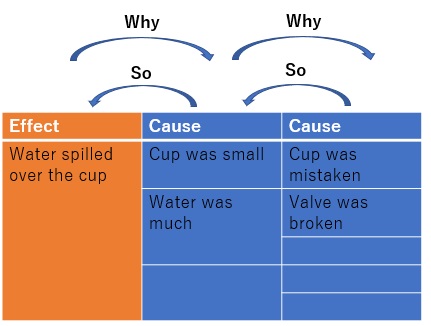
Why-why analysis is sometimes used as a technique, but it is also used as basic knowledge when using the Seven QC Tools and New Seven QC Tools .
Why-why analysis is a method of finding solutions by repeating the "why". Based on my experience and knowledge, I will come up with a lot of hypotheses and reasons.
"5 times of why" means that the relationship between reason and effect is connected, and there are four stages from the lowest cause to the highest result.
Sometimes it is said, "Repeat why five times." Whether or not you can reach the root cause if you do it five times depends on the situation.
In the Fishbone diagram (Cause-and-Effect Diagram) , it is said, "Let's separate the factors from the perspective of 5M + 1E (sometimes 4M or 5M depending on the literature)."
When proceeding with why-why analysis, when you don't know what direction to think about the first why, it is one way to refer to this classification.
In the why-why analysis, write the results on the far left, and on the right side write the reasons that come to mind after asking yourself "why".
It's good to have a lot of "why"s, but don't stop there, check the analysis results. How to check For example, "The cup was small, so the water spilled."

If you can't tell if something is true from words alone, you may need to observe and experiment with the actual object.
NEXT 

 Mind map
Mind map
